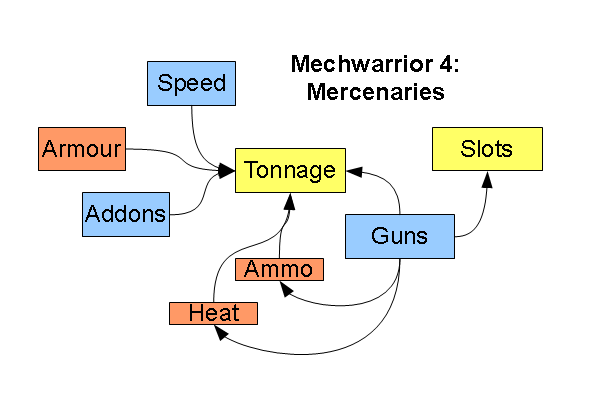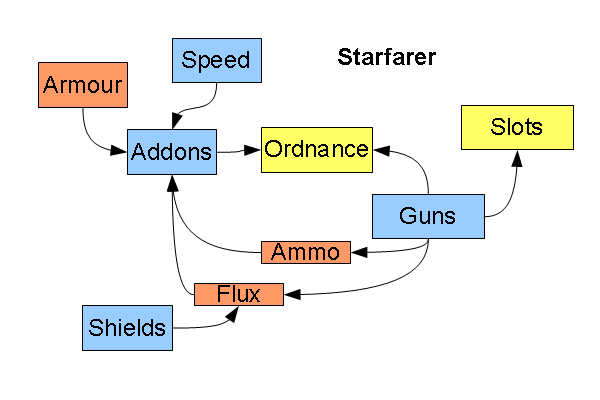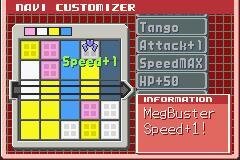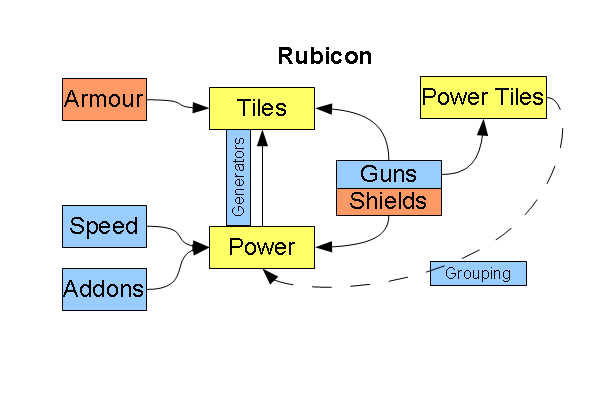I want ship modification to be a major aspect of Rubicon. To that effect, I’ve been working to put together a customization system for the game. It’s harder than it sounds! How do you approach putting together a balanced economy of choices?
By looking to see how other people have done it, of course. I tried to boil down the system of provided resources, how players can allocate those resources, and the resulting in-game effects for Mechwarrior 4: Mercenaries. This is what I came up with:
For each mech, you have some amount of tonnage and weapon slots. There are a couple of other details that differentiate between different chassis (base speed, maximum armour, which addons are available), but those two values define the majority of the available options for the player. They can increase any of the red or blue values at the expense of the others.
What’s the point of slots, then? Why not just have a tonnage-only system? –> Because otherwise the choice between all the different models of mech would be utterly bland, differentiated only by a single number. Gun choice is the most significant decision you make in customization in terms of changing your ingame experience, so putting special limits and options on different mechs gives them personality.
But one data point is never enough. I went and did the same sort of analysis to Starfarer, a spaceship game that was recently pointed out to me:
To my surprise, you’ll notice that it’s *almost exactly the same system*. There are two base resources- “Ordnance” instead of “Tonnage” and a more-simplified version of the weapon slot system. You manage ammo, speed, and armour through the addon system rather than managing them directly, but it’s the same net effect. I don’t know if they mimicked Mechwarrior’s system on purpose or if it’s just the best way to do this sort of thing that’s been independently found multiple times, but either way this appears to be the standard way to go.
So! The system for Rubicon’s different than these in a couple ways. I’ve always wanted to try a system that moves away from hardpoints and is a kind of visual, tetris-puzzle-type of thing:
This has led to a couple of problems from straight-up ripping off these polished, tried-and-true systems. Tiles replace tonnage in that they put a hard total limit on the things you can add to a ship, but then what happens to slots? We’ve discussed why they’re important- because otherwise bigger is strictly better.
Additionally, why should somebody care about where they put each gun/shield/component? The position needs to matter, because otherwise there’s no point in using a position-based system. My above example, Megaman Battle Network, imposed a really simple set of rules- no adjacent colors, some had to/could not overlap a certain row- which made both the pieces’ relative and absolute positions matter.
My solution for Rubicon takes a bit from all of these games. Certain tiles will be “power tiles”, and the important components (guns & shields) will require to be on top of certain types of power tiles. I’m playing around with a power-point system where you can allocate power to each component to increase the effectiveness of that piece. Different ships will have different total placeable tile space, different numbers and types of power tiles, and a different number of power points.
I’m still playing around with the system to make it feel good. The above picture worries me because, since you can place guns without needing power tiles by spending a bit of extra power to group them, and you can get extra power by placing generators, more tiles are still strictly better. I’ll work on it.
UPDATE: The above system turned out to be too complicated. I killed the “power” and “grouping” thing and just focused on how many tiles each component took (and whether it requires power tiles). The complexity of the system now comes from the interaction between different pieces.









